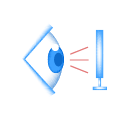01 / 03
HYLO® FRESH
by Ursapharm
IntroductionMedication Usage
Hylo® Fresh
Blocked Tear Duct and Sticky Eyes
-
Foreign body sensation
-
Thick discharge
-
Eyelid redness
-
Conjunctivitis
-
Irritative eyes
Hylo® Fresh Ingredient information
- HYLO® Hyaluronic Acid
- Euphrasia
- Preservatives free
- Phosphates free
HYLO® – Hyaluronic Acid
Distinguishes itself from other similar products on the market. It is synthesized through biotechnology, filtered, and purified. Only hyaluronic acid with “long molecular chains” and a molecular weight between 15,000 to 35,000 Daltons (Da) is selected. Due to its larger molecular weight and length compared to regular hyaluronic acid, it provides more effective and longer-lasting moisturizing and lubricating effects.
High Medicinal Value of Euphrasia
Euphrasia has long been used as a medication for treating conjunctivitis and eyelid inflammation. Due to its vasoconstrictive and antibacterial properties, Euphrasia can alleviate inflammation, form a protective film on the surface of the eye, and provide effective relief for eye fatigue, irritations, and other eye disorders. It is also capable of alleviating excessive tear secretion and itching caused by colds and allergies.
Euphrasia can be widely used in patients of different ages
From infants to children, as research studies have confirmed its practicality and safety. A non-interventional study with anthroposophic eye drops containing Euphrasia on 121 children (aged 0-16 years) suffering from conjunctivitis (hyperemia, lid swelling, purulent secretion, sticky eyes, burning, itching, foreign body sensation). Most of the patients applied the eye drops 3 times a day.
The duration of treatment was 10.4 days on average (±6.3 days). In 119 (= 98 %) cases all or almost all symptoms were cured after 5.2 (±4.1) days. In 2 patients no effect could be observed. In one patient additional treatment with an antibiotic was required. All doctors and almost (99 %) all parents assessed the tolerability of the eye drops as “very good”
Euphrasia-containing anthroposophic eye drops together with physiologic saline solution to 24 premature infants and newborns suffering from a blockade of efflux of tears. In most of the cases the treatment with antibiotics could be avoided.
Therefore the authors recommended Euphrasia-containing eye drops additionally to physiologic saline solution in patients with red or tearing eye with white or yellowish secretion if these symptoms get worse within 48-72 hours. This pilot study confirms the excellent tolerance of Euphrasia-containing eye drops and their efficacy in alleviating unspecific symptoms of eye irritation.
HYLO® FRESH Research findings on the eyeball
Research shows that among 65 patients with irritated eyes, daily use of eye drops containing Euphrasia officinalis (1-5 drops per eye) can effectively alleviate various eye problems caused by external irritants. The tested symptoms include conjunctival redness, swelling, discharge, burning sensation, and foreign body sensation. During the study, the symptoms of the patients’ left and right eyes were recorded on the 7th and 14th day, and compared with the symptom severity on the 1st day (baseline).
According to the above figure1 shows at baseline the right eye is affected in 53 patients, the left in 54 pa- tients. At the first follow-up examination after 7(±3) days, only 23 right and 22 left eyes are still affected. At the second follow-up after 14 (±3) days this symptom is only found in 3 eyes on each side.
According to the above figure2 shows at baseline, the right eye is affected in 11 patients, the left in 12 patients. At the first follow-up after 7(±3) days, only 1 eye on each side is still affected. At the second follow-up after 14(±3) days, no patients present with this symptom.
According to the above figure3 shows at baseline, the right eye is affected in 45 patients, the left eye in 46 patients. At the first follow-up after 7(±3) days, only 17 right and 15 left eyes are still affected. At the second fol- low-up after 14(±3) days, this symptom is only determined in 1 eye on each side.
According to the above figure4 shows at baseline, both eyes in 20 cases each are affected. At the first follow-up after 7(±3) days, only 3 eyes on each side are still affected. At the second follow-up after 14(±3) days, no patients present with this symptom.
According to the above figure5 shows at baseline, the right eye is affected in 13 patients, the left eye in 12. At the first follow-up after 7(±3) days, only 2 right and 3 left eyes are still affected. At the second follow-up after 14(±3) days, no patients present with this symptom.
According to the above figure6 shows at baseline, both eyes are affected in 32 patients. At the first follow- up after 7(±3) days, only 6 right and 5 left eyes are still affected. At the second follow-up after 14(±3) days, this symptom is only determined in 1 right and 2 left eyes.
Comod system is the new future for your eyes

The Patented System
Hylo® FRESH supplied in bottles with the patented COMOD® system.

Preservatives Free
The negative pressure created pulls and the flexible inner sachet more. The inner sachet stays sealed and the liquid is protected against contamination from the air.

Can be used 6 months after opening
The contents remain sterile for a period of use of 6 months.

Drop-by-drop dosage
The COMOD® dosage system makes it possible to dispense exactly one drop per pump stroke.

Compatible with contact lenses
The preserved eye drops can stick to the contact lens material and preservatives can lead to a toxic response on the ocular surface.
HYLO® EYE CARE SERIES
*Friendly Reminder : Before using this product, please consult your doctor if you are an infant, child, or pregnant woman.



























